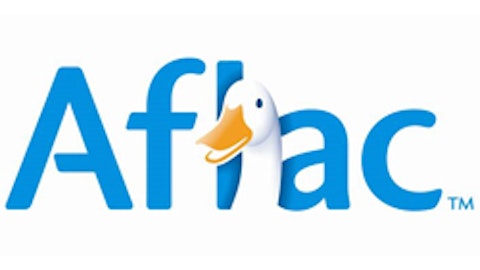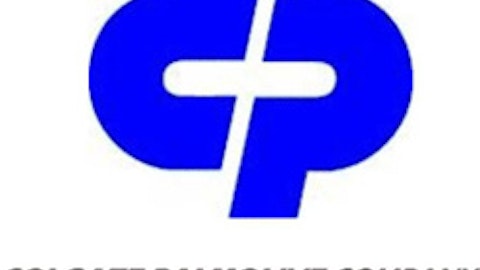Philip Morris International Inc. (NYSE:PM) had a tough second quarter, mainly due to adverse currency fluctuations. Gross revenue, after accounting for excise taxes, came in at $7.917 billion, missing the $8.17 billion consensus by a wide margin. But with almost 29% of global market share excluding the U.S. and China, and significant exposure to emerging economies where there is an increasing population of smokers, the owner of Marlboro might simply be facing bad momentum. Is Philip Morris International Inc. (NYSE:PM) a buy?
Explaining the poor quarter
Let’s start with the bad news. Philip Morris International Inc. (NYSE:PM) had to, once more, cut its 2013 earnings outlook by another 2%. As you can see in the stock performance for the past month, the market did not take this lightly. The good news is that most of the reasons why Philip Morris had to give a pessimistic outlook are exogenous, macroeconomic reasons: the strengthening of the U.S. dollar, the recession in Europe and tax increases in the Philippines and Russia all had a negative influence on sales volume.

You bet it will. Although the proportion of Americans who smoke has been in sharp decline (now only 20% of Americans smoke) due to increasing health and cancer awareness, the situation is different in emerging economies, where in some cases the population of smokers is increasing. In these economies, the proportion of smokers consuming Philip Morris products (Marlboro) is still low, but as their average income increases, I expect a shift to Philip Morris International Inc. (NYSE:PM) products, as iconic brands like Marlboro remain pretty strong and increase social status.

A key market is Asia, where PMI cigarette volume grew 1.5%. In Indonesia industry volume increased by 3.5% in the second quarter while Philip Morris volume grew by 6.0%. As for Japan, the overall cigarette industry volume declined by 2% in the last quarter, and PMI volume is under pressure. However, I believe the strong pipeline of innovative products will protect the market share achieved so far.
Finally, although increasing unemployment is hurting the budget of European smokers, Philip Morris International Inc. (NYSE:PM) is managing to grow, as evidenced by the 0.7% increase in PMI (market share of cigarettes), the 0.5% increase in Marlboro sales and the 1.2% increase in fine cut tobacco sales.
Remember that Philip Morris already has 29% global market share and is probably the largest publicly traded tobacco company in the world. However, recent figures suggest that even after reaching a huge scale in global operations, Philip Morris can keep growing.
The decline in cash flow and high debt ratio are temporary
Due to adverse currency movements and a decrease in net income, Philip Morris International Inc. (NYSE:PM)’ free cash low was down $901 million, or about 18.4% in the first half of 2013. In order to pay its dividend and continue share repurchases, Philip Morris had to use debt, which further increased the debt ratio. Notice, however, that the company’s total debt decreased by $99 million. The reason why its debt ratio increased is because the decrease of cash flow was proportionally more important.
An increase in cash flow will help to fade away debt fears and negative market sentiment. And if Philip Morris hedges well against currencies fluctuations this quarter and keeps up the good work in Asia, we could see cash improvements sooner than expected.
Sell side price-target well above current market price
The sell-side recommends Philip Morris. According to Yahoo! Finance, the mean price target for Philip Morris is $97.86 per share, which suggests a 10% upside from the current price.

Competitors in the U.S. can’t replace Marlboro
British American Tobacco PLC (ADR) (NYSEMKT:BTI) and Reynolds American, Inc. (NYSE:RAI) are two prominent competitors in the American market. In particular, Reynolds American, Inc. (NYSE:RAI) holds the No. 2 position in the U.S. cigarette market thanks to its core brands (Camel and Pall Mall). British American Tobacco PLC (ADR) (NYSEMKT:BTI), on the other hand, is geographically more diverse (with a strong presence in Europe) and owns about 42% of Reynolds American, Inc. (NYSE:RAI).
But none of these brands, from Camel to Lucky Strike, can replace Marlboro, the largest selling brand of cigarettes in the world
Reynolds American, Inc. (NYSE:RAI) actually sold the international rights of its brands to Japan Tobacco back in 1999, and this limits the possibilities for international expansion. In this way, Reynolds American is way too exposed to a market increasingly concerned about health. This is also the reason why the firm’s sales remained flat over the last year.
But even though sales remain flat, Reynolds American’s stock price has increased steadily. The company used to trade at a P/E ratio of 12 until 2011. Since then, a 47% increase in stock price has taken the P/E ratio to 18, quite high for a company with limited international expansion and flat sales in America. This makes Reynolds stock not only expensive, but also exposed to a market correction anytime. And considering that British American Tobacco PLC (ADR) (NYSEMKT:BTI) owns 42% of the company, the risks of Reynolds American, Inc. (NYSE:RAI) are also risks for British American.
The bottom line
It’s no secret Americans are smoking less. This trend will probably strengthen in the future, and the way tobacco companies deal with this fact will eventually determine their future valuations. In this context, Philip Morris International Inc. (NYSE:PM) (a company with exposure to both America and emerging economies) looks very attractive as an investment. Growth in Asia, strong presence in Europe and the fact that its poor earnings were caused only by macroeconomic reasons make Marlboro look attractive over a long-term horizon.
The article This Tobacco Company Offers Great Value originally appeared on Fool.com and is written by Adrian Campos.
Adrian Campos has no position in any stocks mentioned. The Motley Fool owns shares of Philip Morris International. Adrian is a member of The Motley Fool Blog Network — entries represent the personal opinion of the blogger and are not formally edited.
Copyright © 1995 – 2013 The Motley Fool, LLC. All rights reserved. The Motley Fool has a disclosure policy.




